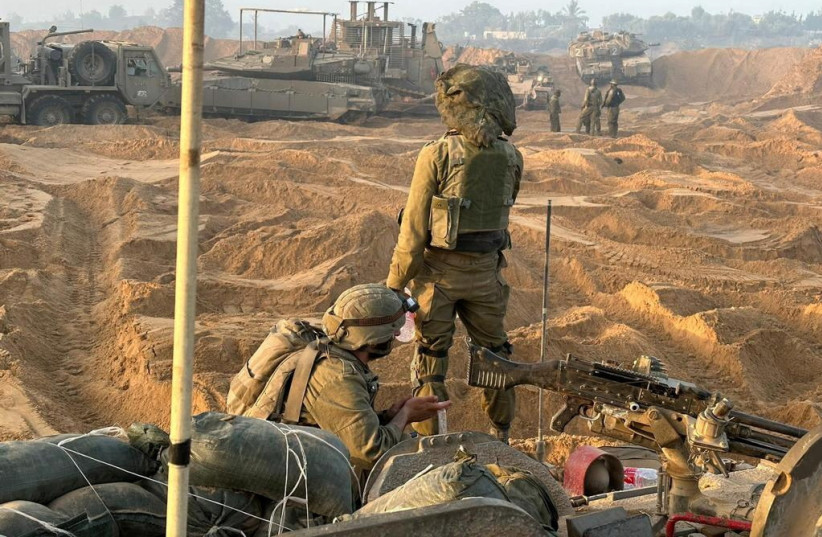Israel’s invasion of Gaza has been very distinctive in how it has been very different than what was originally expected.
One key consequence may be a longer, more drawn-out ground invasion, which could lead to extended tensions in the North.
Not that it causes inherent harm to towns near the Lebanese border, but given the opposing strategies of Hezbollah and the IDF so far, it appears that Jerusalem will not succeed in getting the terror group to halt its provocations any sooner than the end of the war in Gaza.
This was not inevitable and still isn’t.
Rather, it has been a choice by top Israeli leaders that the cost of losing more soldiers (and possibly killing more Palestinian civilians) in a faster invasion of Gaza is higher than the cost of the damage Hezbollah is causing to the Jewish state with violence at current levels.

How is all of this playing out?
Israel could have already chosen to enter Gaza within the first week after the October 7 massacre attack, when its public deadline for Palestinians to evacuate the northern part of the Strip expired by which time there was a significant boost of IDF reserves ready to go into action.
At that point, Hezbollah started to ramp up its rocket, anti-tank, gun, and shooting attacks but had not yet reached their current high levels.
In fact, it was not until around a week in that Israel started a full evacuation of its residents living within 2 km. of the Lebanon border, and not until several days later that the evacuation was extended to those living within 5 km.
An evacuation of Kiryat Shmona came even slightly later.
That means that if Israel had invaded on October 13, the IDF would already have been a week into the invasion by the time Kiryat Shmona was evacuated.
Next, that first week would have been very different from how the first and second weeks of the invasion have actually looked.
Instead of small, tailored incursions of mostly elite forces in Gaza’s north accompanied at all times by air power and artillery support, the IDF could have hurled far more troops in all at once in both the north and southern regions.
Unquestionably, this would result in losing more troops than it has to date.
More ground troops would have moved slower and been easier to ambush; more troops would have been exposed simultaneously to counterattacks by Hamas; more troops would have been in greater proximity to being attacked.
It would have been harder for the air force, artillery, and tanks to guard such a large force all at once and it would have been harder for IDF forces to expose ambushes as they moved through areas quickly, but without being ambushed.
Likewise, it is possible that a slower invasion has allowed more careful target consideration, more warnings to Palestinian civilians, and therefore, more civilian lives saved.
But with weak resistance, almost all fighting being guerrilla warfare, and no consistent defense line that Hamas has presented, the IDF might have been able to achieve initial control of all of Gaza’s major centers within a couple or a few weeks.
In other words, the main fight for Gaza might have been over by now, and we might have already reached the stage of fighting pockets of insurgency, versus a collective, united Hamas military machine.
No one knows exactly when Hezbollah will stop firing on Israel and return to calmer, peacetime levels of violence on the border.
Yet, it is fair to say that Hezbollah will not stop as long as the main invasion continues and as long as the terror group believes that its keeping the pressure on could shorten Israel’s invasion, and give Hamas a better chance to survive in some fashion.
It is also fair to say that once the main invasion of Gaza is over, the IDF will become less tolerant of Hezbollah’s provocations and will gradually escalate toward a threat of much greater attacks across Lebanon if the Lebanese-based terrorist group does not halt its provocations.
Whether the process of convincing Hezbollah to return to the quieter pre-war border status takes days, a week, or a month after the end of the main Gaza conflict, those two events are likely connected.
This means that if the IDF continues its slow-motion invasion of Gaza and does not complete the main stage of wiping out Hamas’s primary forces for months, Hezbollah’s attacks may also last for months.
This also means that evacuees from the North may need to spend months longer as “refugees,” internally displaced evacuees, from their homes than if the invasion had started and moved forward at a much faster pace.
For force protection and for avoiding killing Palestinian civilians, this may be the right move.
But it is important that the public understands the trade-offs because nothing in this war – or in this world – comes for free.
